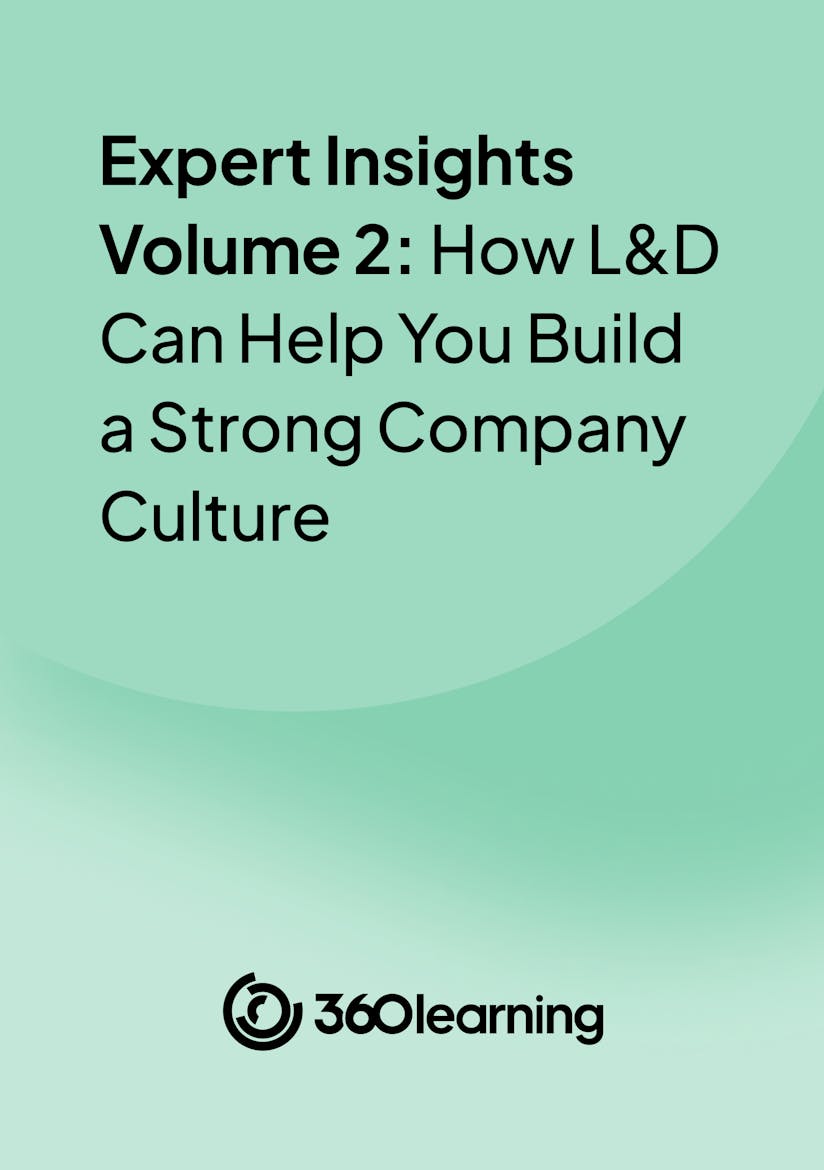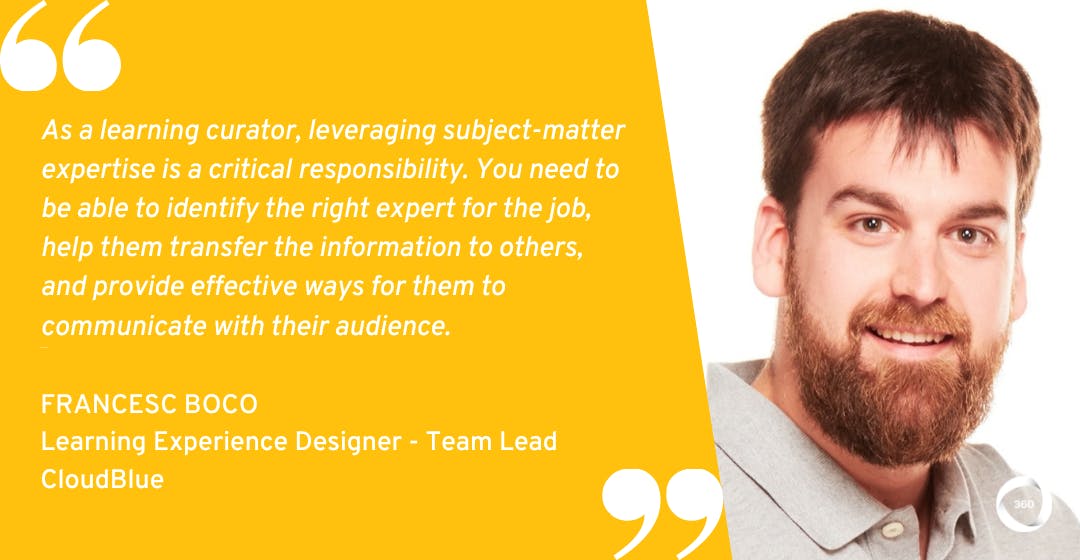As L&D practitioners, we recognize the challenges that onboarding new hires presents. Often, it can take a long time to train and equip new hires with the skills, knowledge, and confidence to start performing at the expected level. This is particularly true in complex industries like SaaS and XaaS, where time to competency can be lengthy.
Added to this challenge, the Great Resignation has resulted in some employees leaving before they have even reached full competency. So, how can organizations cut down time to competency and retain employees?
In my latest interview, I speak with Francesc BoCo, Learning Experience Designer - Team Lead at CloudBlue who provides answers to these critical questions. From his three steps for facilitating knowledge sharing to the best metrics for gauging training effectiveness, Francesc shares his insights on building a culture of knowledge sharing through learning curation.
So, why is knowledge-sharing learning crucial for a business-to-business XaaS company like CloudBlue? Read on to hear more.
Loving what you’re reading? Come and join the L&D Collective for more great learning insights, resources, and events!
The biggest challenge facing CloudBlue today
As a software company, the biggest challenge facing CloudBlue is the complexity of its work in the subscription economy.
“Naturally, this complexity results in a long employee time to competency or in other words, readiness to perform as we expect,” says Francesc. “For some positions, it can take as long as six months to a year to have them ready and onboarded at the level we want.”
The Great Resignation, Francesc explains, has also impacted the business during the last few years. A high churn rate of employees leaving to pursue other projects is only making the task of onboarding more difficult—a long time to readiness combined with employees leaving has a significant impact on the company.
“Building a culture of knowledge sharing is quite difficult when someone with a lot of knowledge leaves as few people know how to perform that role properly. This is a tough situation to face and I'm sure it’s not just our business suffering from this at the moment.”
So, how do Francesc and his team cut down the time to competency? Read on to hear how they are using a learning curation approach to address this challenge and make an impact on the organization.
Looking for more expert tips? Find out how L&D leaders at Harry’s, Robert Half, Disneyland Paris and more are turning L&D into a driver of company culture.

What's company culture without L&D?
By providing your contact info, you agree to receive communications from 360Learning. You can opt-out at any time. For details, refer to our Privacy Policy.
CloudBlue’s 3-step curation learning approach
Francesc explains that how his team enables knowledge sharing is essential, starting with assessing learning methods.
1. Decentralize the learning process
The basis of pedagogy, as Francesc explains, is the assumption that the instructional designer shows up with all the material and addresses everyone in front of them.
“That kind of worked in the past,” says Francesc, “but as many L&D practitioners will know, we’ve moved onto the idea of andragogy, focusing on facilitating. In practice, this means I’m now in the middle of the group, posing ideas to the group which they can discuss and find solutions to.”
While andragogy is adequate, as Francesc explains, scaling can be challenging and as a result we can see that the educational paradigm is changing. Right now, we can find information in any format, anywhere, at any time.
“The idea of decentralized education is important. The role of the learning experience creator is shifting from ‘I'm the source of truth’ to ‘I'm the curator of the information’. One of the benefits of decentralized education is that a lot of information is available. But choosing what's important for the learner to see and at what time is a hard task,” he says.
But as Francesc explains, it’s impossible to create content for every single request that comes to them. So that they may quickly satisfy the request, they turn to internal subject-matter experts.
CloudBlue’s information curator approach to learning highlights the advantages of collaborative learning. By shifting from being the sage on the stage to the curator of knowledge, the learning experience design team is free to develop an environment where learners may engage with the content together and create a space where knowledge sharing can occur.
2. Leverage subject-matter experts
Francesc and his team engage their subject-matter experts (SMEs) to create content quickly. This includes videos, podcasts, interviews, and events.
“Instead of creating everything,” he explains, “we need to engage these experts to make them the source of truth. With the many SME tools provided within a learning management system (LMS) can provide, you can give a gamified experience of the person who has the most experience on this topic—it's a great source of truth.”
“As a learning curator, leveraging SMEs is a critical responsibility. You need to be able to identify the right expert for the job, help them transfer the information to others, and provide effective ways for them to communicate with their audience,” says Francesc.

3. Aim for first-time engagement
Adopting a learning curation approach is particularly important for companies like CloudBlue who need to keep track of software updates.
“So, if you are a software company and you train your people to support new software features as they come out, you need to be able to provide that training as quickly as the software company publishes theirs and it needs to be more engaging otherwise you risk employees looking for information outside of your organization.
“We often see engagement as an opportunity. Now, younger generations go to TikTok, and in one second, they decide if they want to keep with that or not.”
Francesc also highlights this engagement opportunity by referencing a recent study that says it takes people two minutes to decide if they want to finish a Youtube video.
“If in the first two minutes,” he says, “they decide that your content is irrelevant, they're gone. So, your training needs to provide a high first-time engagement and you need to understand that if you are not delivering, people will find another way. Sometimes this alternative way can be detrimental to the organization if the internal training hasn’t been followed.
So, are there specific metrics that Francesc uses to assess the success of their training?
Related: Flatiron Health's 3 Initiatives for Driving Engagement and Retention
Measuring the success of knowledge-sharing
When measuring the success of his training, Francesc uses four metrics: engagement, content relevance, performance, and problem identification.
1. Engagement
First, Francesc looks at content engagement.
“For example,” he explains, “with LMS analytics, we can now see the number of people dropping off a video early. If only 20% of people look at this video, we know it's not being delivered successfully.”
“This is a metric we need to measure to gauge interest. Do they like it? Are they actually going through the training? Or do we have a bigger issue?” Francesc says.
While engagement is useful, it doesn’t provide you with the impact of the training, which is essentially what will allow you to scale your headcount in the long run,” he says.
2. Content relevance
Next, Francesc likes to measure the usefulness of content made easy with the inclusion of ‘is this content useful?’ in their LMS.
“This is really powerful because people's responses say, ‘hey, this is relevant for me’, or ‘I'm an expert on that’, or ‘this is outdated’. These are the most important metrics for me because it shows if learners value the content,” says Francesc.
3. Performance change
For Francesc, it is also essential to monitor business metrics. Are they selling to more firms? Are they convincing more people to join the company?
“These are important metrics that any sales enablement team needs to look at because if you're delivering everything, but you’re unable to close deals, then you are failing. Even if all your other metrics suggest you’re succeeding, if you’re not impacting the business, you have a problem” he explains.
4. Problem identification
Finally, Francesc will ask his team what the problem is they are trying to solve, and what success looks like.
But in addition to this, you must also ask “How do we know it is a problem?” explains Francesc. “What metrics give us the exact information that shows it's a problem? This also provides the metrics we need later to see if we are actually impacting something.”
“I will always ensure I can find the metric impacting the business ahead of engagement. While engagement is useful, it doesn’t provide you with the impact of the training, which is essentially what will allow you to scale your headcount in the long run,” he says.
Thanks to Francesc for sharing his three steps and learning curation insights with us!
For more expert advice on approaches to collaborative learning, check out our interview with Cheryl Haga about Deel’s enablement collaboration strategy to develop trusted relationships and deliver learning at pace. You can also check out Maria Gentile-Feay’s five-step approach to becoming a successful learning business partner through empathy-focused L&D at Quantum Health.
Want more peer insights on transforming workplace learning? Sign up to become a member of the L&D Collective, and check out our other #CLOConnect interviews with top L&D leaders on driving growth and scaling culture through Collaborative Learning. Or you can subscribe (below 👇) to our weekly newsletter to receive our latest posts directly in your inbox.


